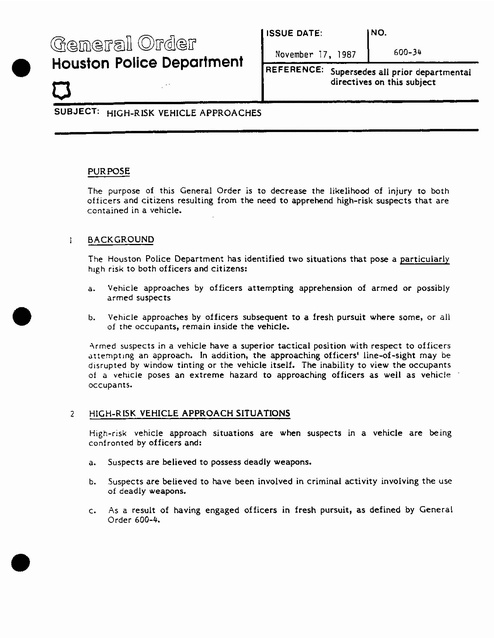Houston Police Department General Order Subj High Risk Vehiclle Approaches 1987
Download original document:

Document text

Document text
This text is machine-read, and may contain errors. Check the original document to verify accuracy.
• @@[ill@u®ll (Q)u@@IT Houston Police Department o NO. ISSUE DATE: November 17, 1987 600-34 REFERENCE: Supersedes all prior departmental directi yes on this subject SUBJECT: HIGH-RISK VEHICLE APPROACHES PURPOSE The purpose of this General Order is to decrease the likelihood of injury to both officers and citizens resulting from the need to apprehend high-risk suspects that are contained in a vehicle. BACKGROUND The Houston Police Department has identified two situations that pose a particularly high risk to both officers and citizens: • a. Vehicle approaches by officers attempting apprehension of armed or possibly armed suspects b. Vehicle approaches by officers subsequent to a fresh pursuit where some, or all of the occupants, remain inside the vehicle. o\rmed suspects in a vehicle have a superior tactical position with respect to officers attempt 109 an approach. In addition, the approaching officers' line-oi-sight may be disrupted by window tinting or the vehicle itself. The inability to view the occupants of a vehicle poses an extreme hazard to approaching officers as well as vehicle occupants. 2 HIGH-RISK VEHICLE APPROACH SITUATIONS High-risk vehicle approach situations are when suspects in a vehicle are being confronted by officers and: • a. Suspects are believed to possess deadly weapons. b. Suspects are believed to have been involved in criminal activity involving the use of deadly weapons. c. As a result of having engaged officers in fresh pursuit, as defined by General Order 600-4• ISSUE DATE: November 17, 1987 3 PAGE # 2 PROCEDURES In the above situations officers will adhere to the following guidelines: a. Attempt to establish verbal communications with suspects, while maintaining a position of advantage. b. If verbal communications can be established, have the suspects exit the vehicle one at a time, using verbal commands. c. Each suspect should be secured before others are made to exit the suspect vehicle. It is obvious that, on many occasions, the actions of HIGH-RISK suspects will not allow officers to maintain a position of advantage or establish verbal communications (i.e., when suspects flee on foot). The HIGH-RISK suspects' actions will dictate whether or not this policy can be used to enhance safety. If HIGH-RISK suspects refuse to comply with verbal commands given by officers maintaining a position of advantage (i.e., flee on foot), officers should then use their own discretion to make the apprehension in accordance with existing departmental procedures. The officers must have a back-up unit before attempting the arrest of HIGH-RISK suspects who refuse to exit a vehicle. A supervisor will make all scenes where a suspect's refusal. to exit a vehicle has required the use of a back-up unit. •





